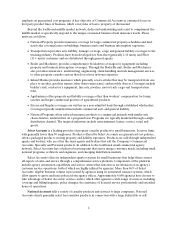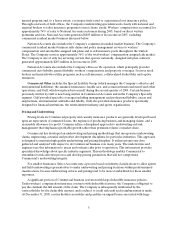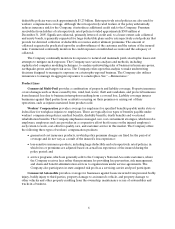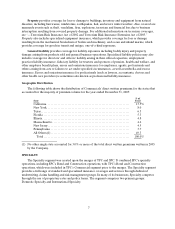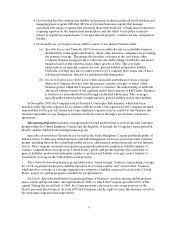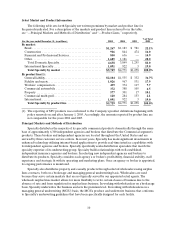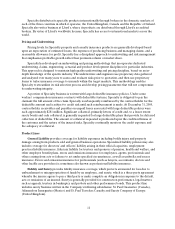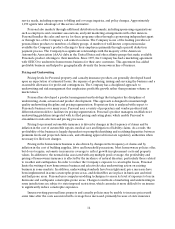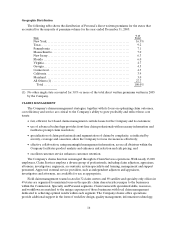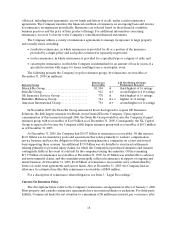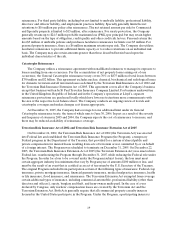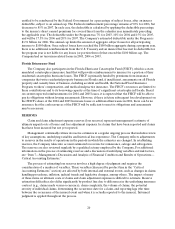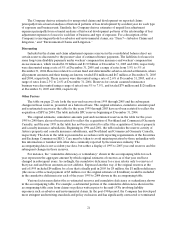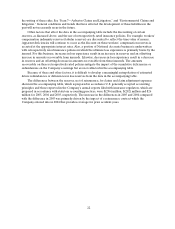Travelers 2005 Annual Report Download - page 26
Download and view the complete annual report
Please find page 26 of the 2005 Travelers annual report below. You can navigate through the pages in the report by either clicking on the pages listed below, or by using the keyword search tool below to find specific information within the annual report.14
service needs, including response to billing and coverage inquiries,and policy changes. Approximately
1,190 agents take advantage of this service alternative.
Personal also markets through additional distribution channels, including sponsoring organizations
such as employers and consumer associations, and joint marketing arrangements with other insurers.
Personal handles the sales and service for these programs either through a sponsoring independent agent
or through two of the Company’s call center locations. The Company is one of the leading providers of
personal lines products to members of affinity groups. A number of well-known corporations make
available the Company’s product offerings to their employees primarily through a payroll deduction
payment process. The Company has significant relationships with the majority of the American
Automobile Association (AAA) clubs in the United States and other affinity groups that make available
Personal’s product offerings to their members. Since 1995, the Company has had a marketing agreement
with GEICO to underwrite homeowners business for their auto customers. This agreement has added
profitable business and helped to geographically diversify the homeowners line of business.
Pricing and Underwriting
Pricing levels for Personal property and casualty insurance products are generally developed based
upon an expectation of estimated losses, the expense of producing, issuing and servicing the business and a
reasonable allowance for profit and contingencies. The Company has a disciplined approach to
underwriting and risk management that emphasizes profitable growth rather than premium volume or
market share.
Personal has developed a product management methodology that integrates the disciplines of
underwriting, claim, actuarial and product development. This approach is designed to maintain high
quality underwriting discipline and pricing segmentation. Proprietary data is analyzed with respect to
Personal’s business over many years. Personal uses a variety of proprietary and vendor produced risk
differentiation models to facilitate its pricing segmentation. Personal’s product managers establish strict
underwritingguidelines integrated with its filed pricing and rating plans, which enable Personal to
streamline its risk selection and pricing processes.
Pricing for personal automobile insurance is driven by changes in the frequency of claims and by
inflation in the cost of automobile repairs, medical care and litigation of liability claims. As a result, the
profitability of the business is largely dependent on promptly identifying and rectifying disparities between
premium levels and projected claim costs, and obtaining approval from state regulatory authorities when
necessary forfiled rate changes.
Pricing in the homeowners business is also drivenby changes in the frequency of claims and by
inflation in the cost of building supplies, labor and household possessions. Most homeowners policies offer,
but do not require, automatic increases in coverage to reflect growth in replacement costs and property
values. In addition to the normal risks associated with any multiple peril coverage, the profitability and
pricing of homeowners insurance is affected by the incidence of natural disasters, particularly those related
to weather and earthquakes. In order to reduce the Company’s exposure to catastrophe losses, Personal
limits the writing of new homeowners business and selectively takes underwriting action on existing
business in some markets. In addition, underwriting standards have been tightened, price increases have
been implemented in some catastrophe-prone areas, and deductibles are in place in hurricane and wind
and hail prone areas. Personal uses computer-modeling techniques to assess its level of exposure to loss in
hurricane and earthquake catastrophe-prone areas. Changes to methods of marketing and underwriting in
some jurisdictions are subject to state-imposed restrictions, which canmake it more difficult for an insurer
to significantly reduce catastrophe exposures.
Insurers writing personal lines property and casualty policies may be unable to increase prices until
some time after the costs associated with coverage have increased, primarily because of state insurance


